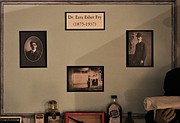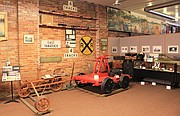Museum is more than just a tourist attraction
When you think about museums, you might think about the Metropolitan or the Louvre, those large, popular tourist attractions known worldwide. Important both culturally and historically, museums give us a glimpse of life in another place and time, providing a snapshot of a world long past or facing extinction.
Local museums are just as vital as their famous counterparts. They preserve the flavor of local culture and the daily lives of those people who founded towns and cities, providing insight into their rituals and religion, food and art, and more.
It’s a job that Susan Kemmis and Dottie Gray, mainstays of the Boundary County Historical Society and Museum, have been devoted to for 14 and 10 years respectively. “You never know what’s going to walk through the door,” Kemmis said in reference to the artifacts they receive.
“Sometimes an exhibit is created because of one artifact but you pull from other places to create a scene,” she continued. All it takes is one good lead to “find the rest of the story.”
In 1999 at a public lecture, the late president of the Commonwealth Association of Museums Emmanuel N. Arinze said that museums are “custodians of the cultural soul.” Much more than tourist attractions, museums connect us to the past, making it a breathing, living entity.
Gray echoed the sentiment. “We try to make those types of connections whenever possible,” she said, citing the progression of technology from their Edison phonograph to an iPod as an example. “Sue will show them the cylinders made of wax and the needle that goes around to play the music […] and we talk to them about [it].”
“As they’re walking around with earbuds,” Kemmis laughed before taking on a more serious tone. “I also think that in a way, [the museum is] giving them a sense of home.”
They watch generations of locals come in, adults who share how they came as children, now bringing their own kids.
Those children are a big part of why they do what they do, “so our grandchildren will know, and our great-grandchildren,” Kemmis said. “We need to pass it down to the next generation.”
It’s an idea Arinze backed up in his lecture, saying that museums “hold the cultural wealth of the nation in trust for all generations,” and that “one of the fundamental objectives of the museum is to educate […] they assist our future generations to understand and appreciate their history and culture and take pride in the achievements of their forebearers.”
It’s a principle that can be concentrated even further at the local level.
Kemmis and Gray design special programs for local fourth-graders and home-schooled students. The activities vary and have been on hold through the pandemic, but they look forward to hosting students again. It’s fun for them and the students, the pair said.
“We […] visit the school in March or April,” Kemmis said, “and take them the Edward Bonner story, tell them how Bonners Ferry got its name.” The last two weeks of the school year they arrange for a field trip for the fourth-graders, the year students begin to learn Idaho history.
“One year we did the walk of the town,” Kemmis remembered. “We took everyone back 100 years ago […] Whatever that business was at the time 100 years ago, there would be an actor there playing the part.” Dressed in period clothing, of course.
City Administrator Lisa Ailport greeted the children at the city office and talked to them a little bit about the city. “We needed someone to play the part of the bank robber,” Kemmis remembered, so Dave Anderson, the mayor at the time, played the part and “robbed” his own bank, handing out chocolate coins to the kids. The site of Zimmerman’s Meat Market had a “pickle barrel” where all the kids could reach in and get a pickle, just like the old days.
Supporting the museum is more than just money. It’s donations of artifacts, time, visiting the museum or buying things from the gift shop, just many of the ways the public can contribute to the museum.
But what will happen to the museum when Kemmis and Gray are ready to retire? It’s a question they ask themselves regularly.
The youngest member of the Historical Society is 61 years old, leaving Kemmis and Gray with an unclear vision of the future.
The years they’ve spent cataloging and caring for the artifacts, newspaper clippings and photographs declare their devotion to the community and its history.
“It’s a huge responsibility,” Gray said. “There’s a lot to preserve.” It’s a labor of love but one with no clear successor.
How long will they keep at it?
When asked this question, both women grew quiet for a few moments, Kemmis finally answering with “until we find someone to do this.”
You can visit the museum Thursday through Saturday, 10 a.m. to 3 p.m., at 7229 Main St. or contact them at doyouremember@meadowcrk.com or 208-267-7720.





